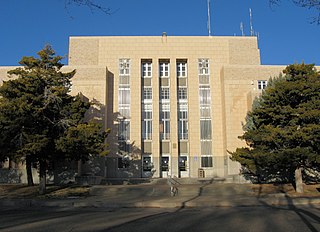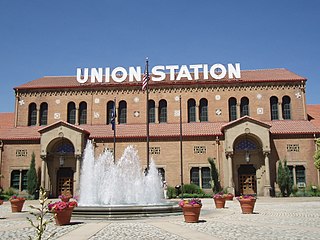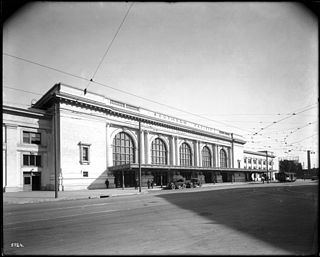
Tucumcari is a city in and the county seat of Quay County, New Mexico, United States. The population was 5,278 at the 2020 census. Tucumcari was founded in 1901, two years before Quay County was established.

The Southern Pacific was an American Class I railroad network that existed from 1865 to 1996 and operated largely in the Western United States. The system was operated by various companies under the names Southern Pacific Railroad, Southern Pacific Company and Southern Pacific Transportation Company.

The original Chicago, Rock Island and Pacific Railroad was an American Class I railroad. It was also known as the Rock Island Line, or, in its final years, The Rock.

The St. Louis–San Francisco Railway, commonly known as the "Frisco", was a railroad that operated in the Midwest and South Central United States from 1876 to November 21, 1980. At the end of 1970, it operated 4,547 miles (7,318 km) of road on 6,574 miles (10,580 km) of track, not including subsidiaries Quanah, Acme and Pacific Railway and the Alabama, Tennessee and Northern Railroad; that year, it reported 12,795 million ton-miles of revenue freight and no passengers. In 1980 it was purchased by and absorbed into the Burlington Northern Railroad. Despite its name, it never came close to San Francisco.

The San Diego and Arizona Railway was a 148-mile (238 km) short line U.S. railroad founded by entrepreneur John D. Spreckels, and dubbed "The Impossible Railroad" by engineers of its day due to the immense logistical challenges involved. It linked San Diego, its western terminus, with El Centro, its eastern terminus, where passengers could connect with Southern Pacific's transcontinental lines, eliminating the need to first travel north via Los Angeles or Riverside.

The St. Louis Southwestern Railway Company, known by its nickname of "The Cotton Belt Route" or simply "Cotton Belt", was a Class I railroad that operated between St. Louis, Missouri, and various points in the U.S. states of Arkansas, Tennessee, Louisiana, and Texas from 1891 to 1980, when the system added the Rock Island's Golden State Route and operations in Kansas, Oklahoma, and New Mexico. The Cotton Belt operated as a Southern Pacific subsidiary from 1932 until 1992, when its operation was assumed by Southern Pacific Transportation Company.

The Golden State was a named passenger train between Chicago and Los Angeles from 1902–1968 on the Chicago, Rock Island and Pacific Railroad and the Southern Pacific Company (SP) and predecessors. It was named for California, the “Golden State”.

Englewood Union Station was a major rail junction and passenger depot in the Englewood neighborhood of Chicago, Illinois. Four railroads served the station in its prime – the Chicago, Rock Island and Pacific Railroad, the New York Central Railroad, the Pennsylvania Railroad, and New York, Chicago and St. Louis Railroad, which operated over the New York Central via trackage rights. The station closed in 1978 when the Rock Island closed intercity rail operations and intermediate stops between LaSalle Street and Gresham. There are presently no plans to reopen the station.

Railroad Wars were business rivalries between railroad companies, which occurred frequently in American history. Although they were usually little more than legal disputes inside a courtroom, they sometimes turned into armed conflicts. There has been competition between railroad companies since the beginning of railroading in the United States, but violent confrontations were most common in the final quarter of the 19th century, particularly in the Old West.
The Choctaw Rocket was a named passenger train operated by the Chicago, Rock Island and Pacific Railroad between Memphis, Tennessee, Little Rock, Oklahoma City, and Amarillo. Initially designated as train No. 51 (westbound) and train No. 52 (eastbound), it was the first diesel powered streamliner to operate out of Memphis, Tennessee, as well as the first streamliner service in the state of Arkansas.

Phoenix Union Station is a former train station at 401 South 4th Avenue in downtown Phoenix, Arizona, United States. From 1971 to 1996 it was an Amtrak station. Until 1971, it was a railroad stop for the Santa Fe and Southern Pacific Railroads. Union Station was served by Amtrak's Los Angeles–New Orleans Sunset Limited and Los Angeles–Chicago Texas Eagle. The station is on the National Register of Historic Places.

Memphis Union Station was a passenger terminal in Memphis, Tennessee. It served as a hub between railroads of the Southwest, the Missouri Pacific Railroad and the St. Louis Southwestern Railway, and railroads of the Southeast, the Louisville and Nashville Railroad, the Nashville, Chattanooga and St. Louis Railway and the Southern Railway. The terminal, completed in 1912, was built in the Beaux-Arts style and was located on Calhoun Street, between south Second Street and Rayburn Boulevard. It was demolished in 1969. This location in south Memphis was approximately two blocks east of the other major Memphis railroad terminal, Memphis Grand Central Station.

Memphis Central Station, referred to as Grand Central Station prior to 1944, is a passenger terminal in Memphis, Tennessee. Located along Main Street and G.E. Patterson Boulevard in Downtown Memphis, it currently a service stop for Amtrak's City of New Orleans route, arriving in late evening northbound and in the morning southbound. It is also served by the MATA Trolley system. The building was opened in 1914, and is located within the city's South Main Arts District. It is also an contributing property to the South Main Street Historic District of the National Register of Historic Places, as are the National Civil Rights Museum and other historic properties within the district boundaries.

Union Station, also known as Ogden Union Station, is a train station in Ogden, Utah, United States, at the west end of Historic 25th Street, just south of Ogden Central station. Formerly the junction of the Union Pacific(UP) and Central Pacific (CP) railroads, its name reflects the common appellation of train stations whose tracks and facilities are shared by railway companies.

Oklahoma City Union Depot is a building in Oklahoma City, Oklahoma that served as a "union station" from 1931 until 1967. It was listed on the National Register of Historic Places in 1979. It now houses the offices of the Scissortail Park Foundation.

Great Overland Station, listed on the National Register of Historic Places as Union Pacific Railroad Passenger Depot, is a museum and former railroad station in Topeka, Kansas, United States. The station was built from 1925 to 1927 and designed by Gilbert Stanley Underwood, whose firm designed over 20 Union Pacific Railroad stations from 1924 to 1931. The station's Free Classical Revival design uses terra cotta extensively and features a center pavilion with two increasingly smaller pavilions on either side. Passenger service to the station began in January 1927; almost 20,000 people attended the station's grand opening, and the new station was considered "one of the largest and finest stations west of the Missouri River". In the later years of its train station life, it also hosted the passenger trains of the Chicago, Rock Island and Pacific Railroad. The Atchison, Topeka and Santa Fe Railway 'Santa Fe' had its trains stop at its own Topeka station.

Central Station was the Southern Pacific Railroad's main passenger terminal in Los Angeles, California. It was formerly on Central Avenue at Fifth Street, in eastern Downtown Los Angeles. The primary hub for Southern Pacific's passenger operations in Southern California, it was served by the Sunset Limited, Coast Daylight, Golden State, and other named trains. The station replaced the company's previous Los Angeles terminal, Arcade Depot, and was often referred to by the name of the older facility.
The Imperial was a night train of the Rock Island and the Southern Pacific. It operated from Chicago to Los Angeles, via Kansas City (Missouri) and Tucumcari.
The Californian was a passenger train of the Southern Pacific on its route between Los Angeles and El Paso, Texas, and over connecting lines as far as Chicago. Trains numbered 1 and 2 with standard and tourist sleepers from Los Angeles began service on January 3, 1910, over the El Paso and Southwestern Railroad (EPSW) from El Paso to Tucumcari, New Mexico, and thence over the Chicago, Rock Island and Pacific Railroad initially to Kansas City, and extended to Chicago on February 26, 1915. Southern Pacific assumed control of the EPSW in 1924. The great depression caused cancellation of the Californian on September 21, 1930, retaining service as far as Calexico, California, as the Imperial trains 13 and 14. A Californian of modern economy chair cars and tourist sleepers resumed service between Los Angeles and Chicago on January 3, 1937, as trains numbered 43 and 44. On May 18, 1947, trains 43 and 44 were renamed the Passenger as far as Tucumcari, connecting with Rock Island trains 111 and 112 to Oklahoma City and Memphis, Tennessee. Trains 43 and 44 between Los Angeles and Tucumcari were renamed the Cherokee from March 13, 1949, until the name was dropped when the train became head-end cars only with a single rider coach on July 8, 1951. Trains 43 and 44 last ran on January 9, 1955.
The Apache was a passenger train of the Southern Pacific on its route between Los Angeles and Tucumcari, New Mexico, and over the connecting Rock Island to Chicago. Service over this route had begun as the Golden State Express on February 1, 1925, until the name was changed to Apache. Trains initially carried coaches plus standard and tourist sleepers between Los Angeles and Chicago. On December 11, 1932, the great depression caused consolidation of the Apache with Rock Island trains 7 and 14 east of Tucumcari. The train added standard sleepers between Los Angeles and Minneapolis, Minnesota, and between Chicago and Mexico City via Phoenix, Arizona, in October, 1933. Rock Island resumed operation of the Apache as a separate train on June 1, 1935. The Minneapolis and Mexico City sleepers were eliminated from the train on November 1, 1937, and the Apache was eliminated in favor of the Golden State Limited on February 13, 1938.

















